Onychomycosis(Nail mushroom) is damage to the fungal infection of the nail plate and its surrounding structures: nails rollers, matrix (jackets of the nail) and nail bed.It is manifested by deformation and thickening of the nails, a change in their colors: the nails become white or yellow.
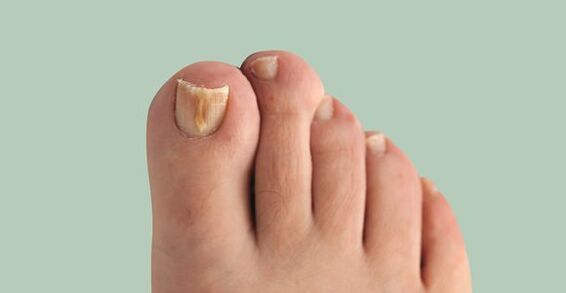
This disease is often found.The prevalence of onychomycosis in the Europeans, according to some reports, reaches 10-12 %, exceeding the well-known indicators of the previous decade.In men, it occurs 1.5 times more often, but contact the doctor 2 times less often than women.Elderly people get sick more often, children are very rare.
The main problem in the treatment of the disease is that patients come to see a dermatologist for a long time after the appearance of the first symptoms.For this reason, the pathological mushroom captures a vast area and the treatment is delayed.
Pathogenic mushrooms can only be transmitted by a sick person.Very often, the infection with a mushroom occurs within the family, since the source is not detected in time and adequate preventive measures are not performed.
Causes of the disease:Very often, direct contact with the patient or objects he uses (shoes, clothes, bathroom rugs, fabrics, supplies for manicures).Often infection occurs when visiting gyms, bathrooms, saunas and swimming pools.
The development of the disease is facilitated by microsenza: interdigital fold cracks that occur due to obtuseness, greater sweating, dry skin, poor drying after water procedures and flat feet.
The mycosis of the nails can also occur in the presence of concomitant diseases of the endocrine system (diabetes, obesity, hypothyroidism), vascular diseases of the limbs (venous deficiency, lymphostasis), immune disorders, as well as when using antibiotics, corticosteroid and cytostatic drugs.As a result of the above diseases, the microcirculation of the blood in the nail area is disturbed and natural immunity is reduced, which contributes to the development of secondary infection.
The onychomicosis causes the following types of mushrooms:
- dermatophyte;
- Mushrooms similar to the yeast of the candid genre;
- molds.
Depending on the type of pathogen, the penetration of a fungal infection and the clinical picture are different, so even the approaches to the therapy are different.
The nails on the legs are affected by a mushroom 10 times more often than at hand.In most cases, dermatophytes cause the mushroom (for example, Trichophophyton Rubrum).The remaining cases are often caused by incoherent molds (Aspergillus, Scopularopsis, Fusarium).
If similar symptoms are detected, consult a doctor.Don't trundiare: it's dangerous for your health!
Symptoms of onychomycosis (nail fungus)
The more the disease proceeds, the more the symptoms become.The main signs of onychomycosis include:
- Dyschromy - A change in the color of the nail in yellow, black, green, gray or brown (the type of color depends on the type of mushroom);
- Onolisi - separation of the nail plate from the box;
- change the thickness of the nail plate;
- Gapalonichia - a power of the thickness of the dish and its softening;
- Koylonia - The nail seems to be concave, in the form of a teaspoon;
- Pahionichia - thickening of the nail plate, nail hypertrophy;
- Onychogrifosis - Trusting, a change in the color of the nail plate, curled in the shape of a beak;
- change in the thickness of the nail bed (hyperkeratosis - inspection of the nail bed);
- Change the surface of the nail plate: it was, furrows, crests;
- Change the rollers for nails and the surrounding skin (paronychy - inflammation of the roller for proximal nails).
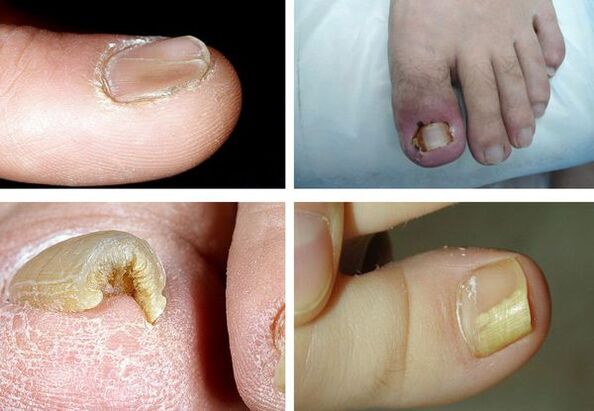
It is important to note that none of the symptoms is pathogen, that is, unequivocally suitable for a particular pathogen, therefore it is impossible to determine it with the symptoms: further exams are needed.
Pathogenesis of the icydomicosis (nail fungus)
The pathogenesis of the disease depends on how the mushroom affects the skin and nails.
Distal submarine type:If the mushroom is introduced through the skin in the nail roller area or the distal region, the spread of the infection occurs through the free edge of the nail in the bed and in addition to the matrix.Initially, the nail plate may not change, but later, due to the hyperkeratosis, it gradually moves away from the nail bed and becomes yellowish.Gradually, a thickening of the nail plate is possible.
Surface white type:If the white outbreaks are formed on the surface of the nail, over time the fungus of the entire nail plate occurs.The nail thickens, crumbles, acquires a gray brown tint.In this case, the matrix and epithelium of the nail bed are not interested.There is no inflammation of the surrounding skin.
Type sub -gear proximal:The mushroom can spread from the skin and from the rollers to the plate for nails and then to the matrix, reaching the distal parts of the nail plate.The stains appear on the nail in the hole area and the nail bed, the nail slab is detached.There is no pronounced inflammation of the bed or matrix.
Total dystrophic type:The entire nail is interested.The proximal areas of the roller for nails disappear or thicken, so that the nail plate can no longer form and grow.
ExistsThe bio -physical concept of the pathogenesis of the Onychomicosis, who says that the clash between the two forces occurs with the disease: a fungal colony that grows in the direction of the matrix and the natural growth of the nail from the matrix to the distal edge.Therefore, the growth rate of the nails is crucial during the onychomycosis: faster the nail has grown, the cure arrives more earlier.Perhaps this is exactly what explains the small prevalence of the disease in children, since their nails grow faster than adults and the elderly.
Classification and phases of the development of onychomycosis (nail fungus)
There is the following classification of onychomycosis:
- Distal submarine;
- superficial white;
- sub -gear proximal;
- Total dystrophic.
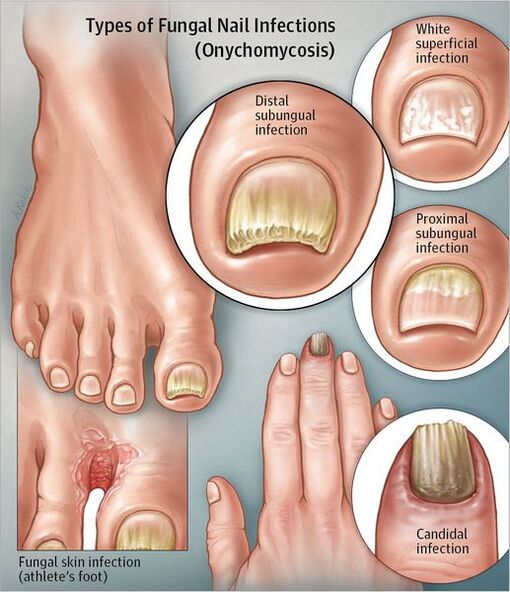
According to the 1970 classification:
- Normorophic: In the thickness of the nail, a yellowish and whitish strip, but the shape of the nail plate does not change, there is no submarine hyperkeratosis;
- hypertrophic:The nail plate becomes yellow, thickens due to the underwater hyperkeratosis, breaks, with jagged edges;
- District:There is a thinning and a removal of the nail plate from the nail bed with the formation of empty.
Complications of onychomycosis (nail fungus)
With onychomycosis existing for some time, the risk of development increasesdiabetic foot(Formation of trophic ulcers on the legs) egangrene, if the patient has diabetes or vascular diseases of the lower limbs.
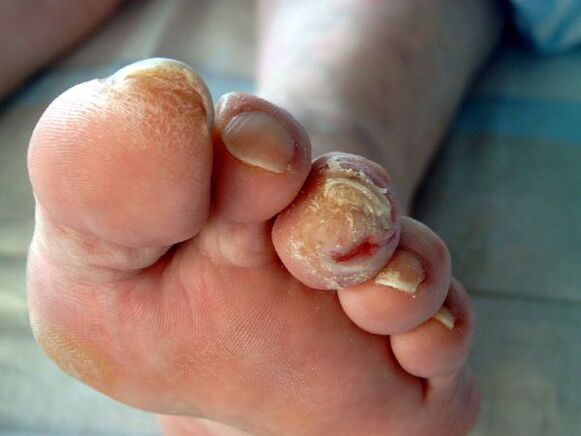
In immunosuPressive conditions (primary and secondary immunodefinals), mushrooms can spread on the skin, internal organs and cause body allergicization.This can be manifested by rashes on the skin up to the development of bronchial asthma.
Diagnosis of onychomycosis (nail fungus)
Before disassembling the methods of diagnosis of onychomycosis, it is necessary to explain how to correctly assemble the material for the study (the patient does it independently or prepares the nails before diagnostics).Before the fence of the study material, it is necessary to treat the nail plate with alcohol with 70 % so that there is no obstruction of other bacteria.
The method of collecting the material varies according to the form of onychomycosis:
- Superficial form- make a scraping from the nail plate;
- Distant shape- A nail bed and a piece of nail plate is needed;
- Proximal submarine form- The material is collected by a drill or a nail biopsy is made or a nail bed scraping.
The fastest method for determining pathological mushrooms in the nail ismicroscopy.Technique: the studied material is treated with a solution of alkali to dissolve keratin.To improve the wires of the mushrooms, the ink is added to the alkali.Subsequently, study the drug resulting in the microscope.
This research method is the fastest and most objective.Sensitivity is up to 80 %.The disadvantages of the method include the fact that when you use it, it is impossible to determine the type of pathogen.
Bacteriological sowing: is an additional method of diagnosis of onychomycosis.The material is sown on a special environment and interpreted the result under the microscope after 2-3 weeks.This method allows you to establish the type of pathogen: this helps to determine the tactics of the treatment and when selecting drugs for sensitivity.But the disadvantage of the study is that it takes a long time and its sensitivity is only 30-50 %.
Biopsy: With the help of a scalpel and with the use of anesthesia, a nail and nail bed are cut.The material is immersed in a formaldehyde solution and sent for an histological examination to the laboratory.The advantages of this method are highly sensitive and allow to determine the presence of a pathological mushroom in the material.
Cons: it is impossible to identify the pathogen, in addition to establishing the feasibility of microorganisms, the high cost and complexity of the method.
Geniodiagnostics: Molecular biological research method (PCR).This is one of the new and highly sensitive methods for the diagnosis of onychomycosis with help, the pathogen DNA is revealed.It is recommended to introduce this type of diagnosis in those medical institutions that have PCR laboratories, but at the moment, the test systems to identify dermatophytes and mold mushrooms provide only to introduce in the laboratory.The method allows you to determine the type of pathogen and its sensitivity is 80-90 %.Cons: high costs, inaccessibility, lack of technological standards and complexity of the execution.
More and more doctors are introduced into practicedermatoscopy.Using this method, it is possible to evaluate a change in the color and structure of the nail, the condition of the surrounding structures.The dermatoscopic examination allows you to more accurately evaluate the depth of the damage to the nail plate and calculate more correctly the index of the severity of the Onyicomicosis.
Treatment of onychomycosis (nail fungus)
There are different types of treatment for onychomycosis:
- Local therapy.
- System therapy.
- Combined therapy.
- Corrective therapy.
Local therapyIt implies the application of nail plate medicines and nail rollers.Indications for local therapy:
- Limited form of nail plate damage.
- There are contraindications for the appointment of systemic drugs: hypersensitivity, liver diseases, kidney function, pregnancy, lactation.
The advantages of this therapy are that high concentrations of a therapeutic agent form on the surface of the nail, which does not penetrate the bloodstream.There are no side effects of the use of antifungal drugs: nausea, a decrease in appetite, abdominal pain.The disadvantage of the method is that the medicinal substance does not always fall into the pathogen habitat, especially if the mushrooms are in the nail bed or in the matrix.This, in turn, can lead to the inefficiency of the treatment.This type of treatment is a long time, since before applying the drug, it is necessary to remove the interested part of the nail.
Ways to remove interested nails:
- Mechanical removal with files, nipper or drill.
- With the help of keratolithic patches.Before applying a keratolithic patch, the skin around the nail is sealed with a patch, a mass of patch (urea with salicylic acid) is applied on the top and sealed with an adhesive patch.The mass of the patch is changed every 2-3 days.After each removal, the interested part of the nail is mechanically removed.
- Surgical.This operation is very painful and traumatic, since when you remove the nail plate, the sprout area can be damaged, which leads to the growth of deformed nails.
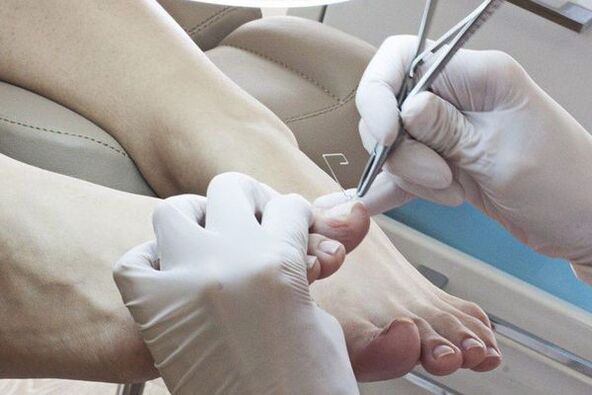
Local antifungal agents are used after removing the affected nail plate.AntifungalDistinguish between the place of application:
- Applied to the nail: paints;
- Apply to the rollers: creams, ointments, solutions.
The most designed tool for local use is a 1 % solution of the group of drugs of the Alfa Group, which has a basis for tests in the treatment in treatment based on Cocraranial Meta-analysis.This tool has a water base, which contributes to the best penetration of the antifungal substance on the destruction site.The paints have a dehydrated base that reduces the penetration of the drug into deep layers.Therefore, dermatologists consider the use of unsatisfactory paints and more often prefer a water -based tool.
To obtain the result from local therapy, it is necessary to observe the treatment regime, it is important that the patient is responsible, coherent and patient.The duration of the therapy can reach 12 months.
System therapyIt allows the anti -flaung drug to penetrate through the blood to the lesion, even if the bed and the matrix are affected.The high concentration of the drug remains for a long time in the injury after the end of use.The disadvantages of this type of treatment are associated with the risk of lateral and toxic effects.
Indications for systemic therapy:
- Common forms of damage to the nail plate.
- The absence of the effect of local therapy (i.e. after six months of treatment of the icydomicosis on the hands and 9-12 months of treatment of the oticomicosis of the feet, there were no healthy nails growing).
To determine the treatment tactics, a clinical index of the severity of the uricomicosis is used.It is used as therapeutic standard in various countries around the world.
MedicinesFor the treatment of oticomicosis, it is possible to classify as follows:
- antifungal - have an antifungal effect;
- Antiseptics - have both antifungal and antibacterial effects.They are rarely used, only if there are no other antifungal agents;
- The multicomponent - In addition to an anti -Fungry agent, it contains other drugs, such as anti -inflammatory.
Drugs to prescribe drugs:
- Standard: daily administration of drugs during the prescribed treatment period;
- Shortened: the treatment period is shortened, it can be carried out by conventional or enlarged doses;
- The intermittent treatment is prescribed in several short courses, the intervals between the courses are equal to the duration of the courses;
- The treatment for wrist therapy is prescribed in several short courses, the intervals between the courses are higher than the duration of the courses.
Antifungal drugs are divided essentially:
- Triazoli;
- Alllamine;
- Morpholine.
System therapy is currently usedThird generation drugs only.
With combined therapyLocal and systemic treatment is carried out simultaneously.Combined therapy is used if it is necessary to increase the effectiveness of systemic therapy and reduce treatment periods.
Corrective therapy(Treatment of concomitant diseases): to select a treatment regime, it is necessary to evaluate the general somatic state of the body.Diseases such as circulatory disorders in the arts can reduce the access of the antifungal agent to the lesion.Therefore, the drugs that improve the tissue trophic are prescribed.
Due to the toxic effects of systemic antifungal drugs, it is necessary to exclude liver diseases and, if necessary, prescribe the hepatoptrators.
Forecast.Prevention
First the patient contacts the doctor with signs of fungal nail injuries, faster the disease will be treated and will restore the nail plate.With existing long -term processes with the capture of the entire nail, the treatment of omicomicosis can be long, but under all recommendations, recovery often occurs.If there are contraindications for systemic therapy, long -term support treatment with local drugs is needed.
For preventionIt is necessary to respect the rules of personal hygiene and reduce the possibility of re -infection:
- Try to wear comfortable and high quality shoes (in order to prevent an increase in the sweating of the legs);
- It is recommended to change socks and tights daily;
- Use only individual shoes.Those who suffer a treatment for onychomycosis must be treated at the beginning of the treatment, at least once a month throughout the treatment period and after its end;
- If necessary, use anti -transpirements for the legs;
- use a set of individual nail care (scissors, saws);
- Before and after visiting public places (swimming pool, bathroom, sports room), use antifungal external products (spray, cream and pencils);
- Identify the source of fungal family infection and be treated at the same time.
It is recommended to periodically carry out the antifungal processing of personal objects, shoes, bathrooms, floors and rugs.For these purposes, it is possible to use a 40 % solution of acetic acid, an alcoholic solution to 1 % antiseptic (the prescription is prescribed by a doctor), solutions for disinfection.The lingerie can be boiled in 1-2 % of the Liner Sapone solution for 20-30 minutes, stretched at the maximum temperature.



















